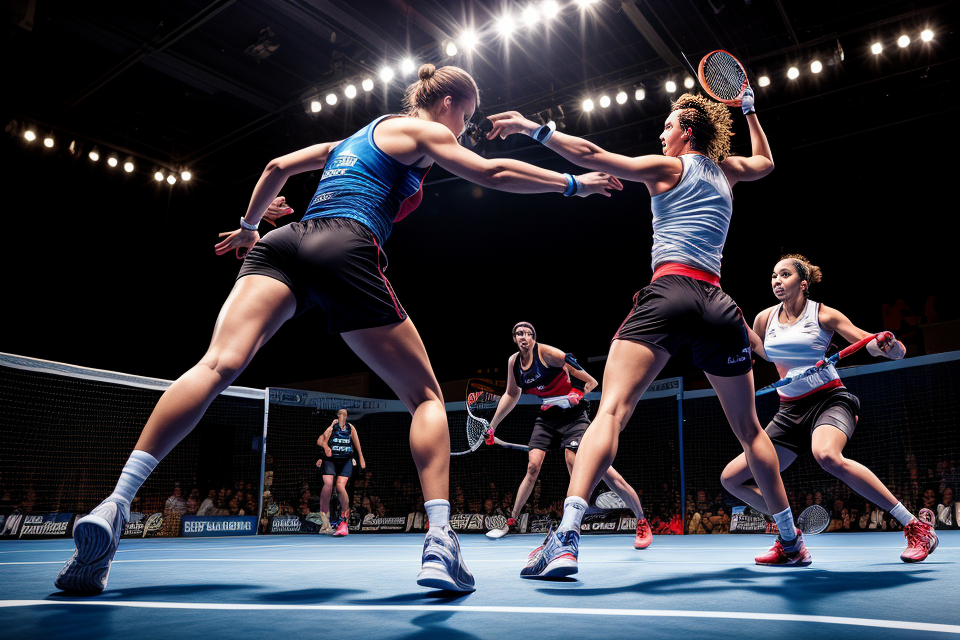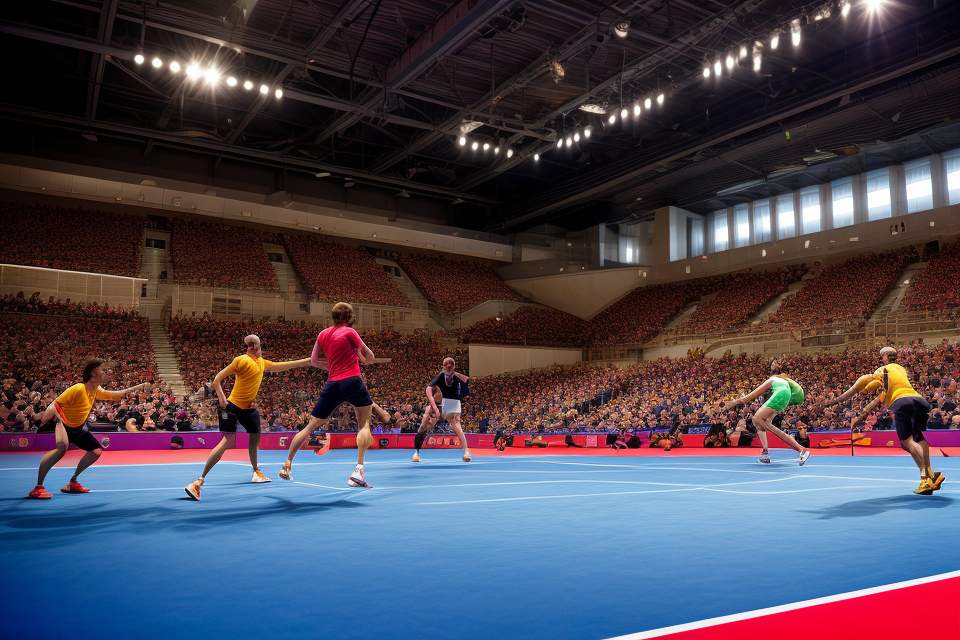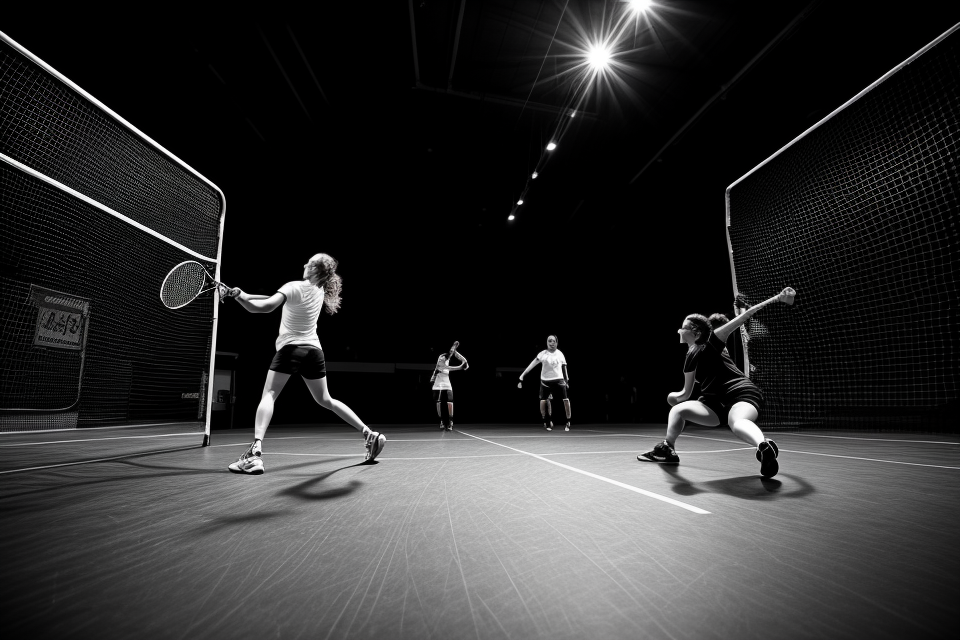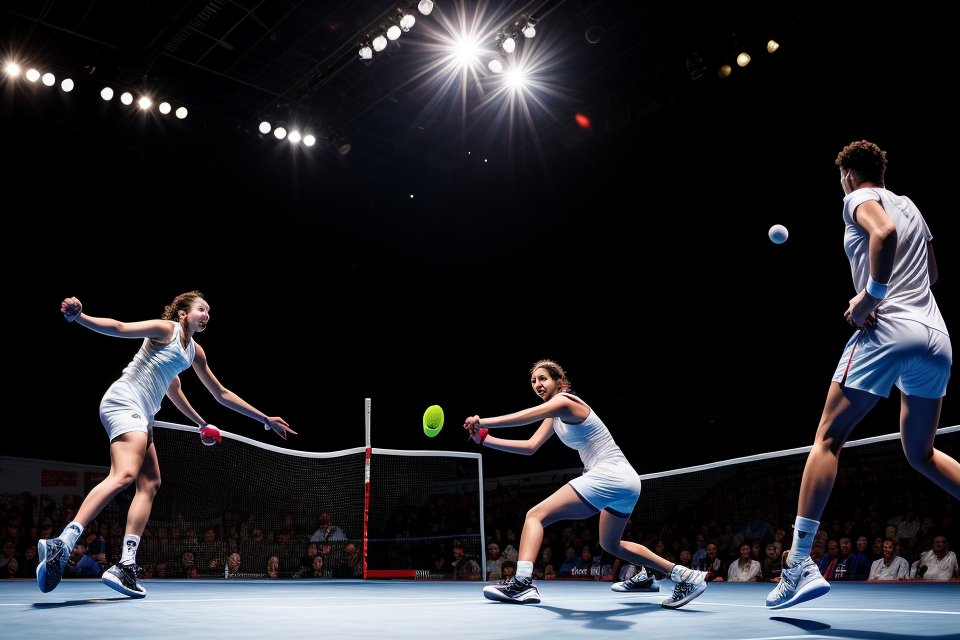Squash is a sport that requires skill, fitness, and strategy to be successful. However, when you find yourself up against a player who is better than you, it can be daunting to know how to beat them. In this article, we will explore some tips and strategies to help you overcome a stronger squash player. Whether you’re a beginner or an experienced player, these tips will give you the tools you need to improve your game and come out on top. So, let’s get started and discover how to take down that tough opponent on the squash court!
Understanding Your Opponent
Analyzing Their Game
In order to defeat a stronger squash player, it is crucial to have a deep understanding of their game. This includes analyzing their strengths and weaknesses, identifying their playing style, and assessing their fitness level. By carefully observing and evaluating your opponent’s game, you can develop effective strategies to outplay them.
- Observe their strengths and weaknesses:
- Look for patterns in their shots and movements to identify their most effective techniques.
- Note any recurring mistakes or weaknesses that you can exploit during the game.
- Observe their physical and mental toughness to determine their endurance and resilience.
- Identify their playing style:
- Determine whether they are an aggressive or defensive player.
- Analyze their shot selection and court positioning to understand their tactics.
- Pay attention to their communication with their teammates or opponents to gauge their teamwork skills.
- Assess their fitness level:
- Observe their stamina and endurance during the game.
- Note any signs of fatigue or exhaustion that may indicate a weakness.
- Assess their flexibility and agility to understand their mobility on the court.
By thoroughly analyzing your opponent’s game, you can develop a tailored strategy to overcome them. Understanding their strengths and weaknesses, playing style, and fitness level can give you a significant advantage in the game.
Adapting Your Game Plan
- Adjust your strategy based on their strengths and weaknesses
- Use their strengths against them
- Exploit their weaknesses
To overcome a stronger squash player, it is crucial to understand their playing style and strengths. One way to do this is by observing their game during the warm-up or previous matches. Pay attention to their strengths, such as their powerful shots or quick movements, and also note their weaknesses, such as their tendency to hit the ball out of bounds or struggle with certain types of serves.
Once you have a good understanding of your opponent’s strengths and weaknesses, you can adjust your game plan accordingly. This might involve changing your own playing style to better match up against them or focusing on exploiting their weaknesses.
For example, if your opponent has a powerful backhand shot, you might want to focus on keeping the ball away from them and hitting more shots to their weaker forehand side. Alternatively, if they struggle with volley shots, you could try to approach the net more often and force them to make difficult volleys.
Overall, adapting your game plan to your opponent’s strengths and weaknesses is a key strategy for overcoming a stronger squash player. By understanding their playing style and adjusting your own approach accordingly, you can increase your chances of winning the match.
Physical Fitness and Conditioning
The Importance of Stamina
In squash, stamina is a crucial aspect that can make or break a match. A strong opponent may have better stamina, which means you need to keep up with them physically. Therefore, it is essential to focus on improving your stamina to perform at your best on the court.
Improving your stamina involves engaging in regular cardiovascular exercises that will help increase your endurance. These exercises should target your heart rate and help you build up your cardiovascular system. Here are some examples of exercises that can help improve your stamina:
- Running: Running is an excellent exercise that can help improve your stamina. It is a high-intensity workout that can help you build endurance and strengthen your legs, which are essential in squash. Start with short runs and gradually increase the duration and intensity of your runs.
- Cycling: Cycling is another great exercise that can help improve your stamina. It is a low-impact workout that can help you build endurance and strengthen your legs. Cycling can also help you work on your cardiovascular system and increase your overall fitness level.
- Swimming: Swimming is a low-impact exercise that can help improve your stamina. It is an excellent workout that can help you build endurance and strengthen your muscles without putting too much stress on your joints. Swimming can also help you work on your cardiovascular system and increase your overall fitness level.
By incorporating these exercises into your fitness routine, you can improve your stamina and increase your chances of winning against a stronger squash player. Remember that consistency is key, and it is essential to incorporate these exercises into your routine regularly to see significant improvements.
Strength Training
Strength training is an essential aspect of improving your performance on the squash court. Squash is a game that requires quick movements and changes of direction, and having strong muscles can help you perform these movements more efficiently.
There are several exercises that you can incorporate into your strength training routine to improve your muscle strength and agility. Here are some examples:
- Lunges: Lunges are a great exercise for building leg strength and improving your balance. They can be done with or without weights, and can be modified to suit different fitness levels. To perform a lunge, start with your feet shoulder-width apart, then take a large step forward with one foot. Bend both knees until your back knee is almost touching the ground, and make sure your front knee is directly above your ankle. Push back up to a standing position and repeat with the other leg.
- Squats: Squats are another excellent exercise for building leg strength and improving your overall power. They can be done with or without weights, and can be modified to suit different fitness levels. To perform a squat, stand with your feet shoulder-width apart, then bend your knees and lower your body as if you were sitting down in a chair. Make sure your knees don’t extend beyond your toes, and keep your back straight. Push back up to a standing position and repeat.
- Planks: Planks are a core-strengthening exercise that can help improve your balance and stability on the squash court. To perform a plank, start in a push-up position, then lower your body until you are in a plank position. Hold this position for as long as you can, making sure to keep your body in a straight line from head to heels. To modify the exercise, you can also do a modified plank on your knees.
By incorporating these strength training exercises into your fitness routine, you can improve your muscle strength and agility, which can help you perform better on the squash court.
Flexibility and Mobility
Importance of Flexibility and Mobility
Flexibility and mobility are crucial aspects of physical fitness and conditioning for squash players. These aspects help prevent injuries and improve your overall performance on the court. A player with good flexibility and mobility can easily move around the court, change direction quickly, and make precise movements with ease.
Improving Flexibility and Mobility
Improving your flexibility and mobility requires consistent effort and practice. Here are some effective exercises and techniques that can help:
Yoga and Stretching Exercises
Yoga and stretching exercises are excellent ways to improve your flexibility and mobility. These exercises help to increase your range of motion, improve your balance, and reduce your risk of injury. Some of the best yoga poses for improving flexibility and mobility include:
- Downward-Facing Dog (Adho Mukha Svanasana)
- Child’s Pose (Balasana)
- Hamstring Stretch (Paschimottanasana)
- Warrior II (Virabhadrasana II)
- Tree Pose (Vriksasana)
Dynamic Stretching
Dynamic stretching is another effective way to improve your flexibility and mobility. Dynamic stretching involves active movements that gradually increase your range of motion. Examples of dynamic stretches include leg swings, arm circles, and hip openers. These stretches can be performed before or after a workout and are great for warming up or cooling down.
Mobility Exercises
Mobility exercises are designed to improve your ability to move freely and efficiently. These exercises often involve movements that require you to reach, stretch, and rotate your joints. Examples of mobility exercises include:
- Ankle mobility exercises, such as ankle circles and ankle pumps
- Hip mobility exercises, such as hip circles and hip openers
- Shoulder mobility exercises, such as shoulder circles and overhead stretches
By incorporating these exercises into your training routine, you can improve your flexibility and mobility, reducing your risk of injury and enhancing your performance on the squash court.
Mental Game
Staying Focused
Maintaining focus during a match is crucial for success
During a squash match, maintaining focus is essential for success. A distracted player is more likely to make mistakes and lose points, which can ultimately lead to a loss. It is important to stay focused on the game and the task at hand, rather than getting caught up in any outside distractions.
Use visualization techniques to help you stay focused
Visualization techniques can be a helpful tool for staying focused during a match. This can include visualizing yourself making successful shots, or visualizing yourself winning the match. By using visualization techniques, you can help your mind stay focused on the task at hand and can help you stay motivated throughout the match.
Avoid distractions and stay in the moment
It is important to avoid distractions during a match, such as thinking about other things or allowing outside influences to affect your game. Instead, it is important to stay in the moment and focus on the current point and shot. By staying in the moment, you can stay focused on the task at hand and make the most of your skills and abilities.
Managing Emotions
During a squash match, it’s common to experience a range of emotions, from nerves to frustration. However, it’s important to learn how to manage these emotions effectively in order to maintain a competitive edge. Here are some tips for managing your emotions during a squash match:
- Stay calm under pressure: It’s easy to get caught up in the heat of the moment during a squash match, but it’s important to try to stay calm and focused. Take deep breaths, remind yourself to stay focused on the game, and try to stay in the present moment.
- Take breaks when needed: If you find yourself getting overwhelmed by emotions, it’s okay to take a break. Step off the court for a few minutes to collect your thoughts, stretch, or take some deep breaths. This can help you regain your composure and return to the game with a clear mind.
- Practice positive self-talk: Sometimes, negative self-talk can creep in during a match, leading to feelings of doubt or frustration. To combat this, try to practice positive self-talk. Remind yourself of your strengths, tell yourself that you can do it, and focus on your successes rather than your mistakes.
- Visualize success: Visualization can be a powerful tool for managing emotions during a match. Spend a few minutes before the match visualizing yourself playing well, making good shots, and winning points. This can help you feel more confident and focused during the match.
- Maintain a positive attitude: Finally, try to maintain a positive attitude throughout the match, even when things aren’t going your way. Avoid getting discouraged by mistakes or setbacks, and instead focus on staying positive and moving forward. Remember that every point counts, and that each point is an opportunity to improve and learn.
Tactics and Techniques
Serving and Serve Return
A Strong Serve Can Set the Tone for the Match
A strong serve can set the tone for the match and give you an early advantage. It is important to practice your serve and focus on accuracy and speed. A well-executed serve can put pressure on your opponent and force them to defend, giving you an opportunity to attack.
Practice Your Serve and Focus on Accuracy and Speed
To improve your serve, practice regularly and focus on accuracy and speed. A good serve should be aimed towards your opponent’s weaknesses and should be delivered with enough pace to catch them off guard. It is also important to vary your serve to keep your opponent guessing and to avoid falling into a predictable pattern.
Returning Your Opponent’s Serve Effectively is Crucial
Returning your opponent’s serve effectively is crucial in squash. A good return should be hit with confidence and pace, and should be aimed towards your opponent’s weaknesses. It is important to practice your return of serve regularly to develop good technique and to improve your reaction time.
In addition, it is important to read your opponent’s serve and to anticipate their movements. This can help you to get into position to hit a strong return and to take control of the point.
Overall, mastering the art of serving and serve return is essential in squash. By practicing regularly and focusing on accuracy, speed, and variety, you can develop a strong serve and return that will give you an edge over your opponents.
Volley and Net Play
When facing a stronger opponent in squash, one effective strategy is to focus on improving your volley and net play. These tactics can help you gain control of the match and disrupt your opponent’s rhythm.
Volley and Net Play
- Volley and net play are crucial skills to master in squash. They allow you to control the pace of the game and put pressure on your opponent.
- To improve your volley, practice hitting the ball while it’s still above the height of your shoulders. This will help you get to the ball more easily and hit it with more power.
- When approaching the net, make sure to keep your eye on the ball and use your non-racket arm for balance. It’s also important to vary your shots and use different volleys to keep your opponent guessing.
- Volley and net play can be used to disrupt your opponent’s rhythm and catch them off guard. Use these tactics to create unpredictability and confusion on the court.
- Another important aspect of volley and net play is to practice your footwork. Quick and efficient footwork is essential for getting to the ball on time and making successful shots.
- Lastly, don’t be afraid to make mistakes when practicing your volley and net play. It’s important to take risks and try new things in order to improve your skills.
Movement and Positioning
- Movement and positioning are essential components of a successful squash game.
- A player who can move quickly and efficiently around the court, while also positioning themselves strategically, has a significant advantage over their opponent.
- Here are some tips to help you improve your movement and positioning on the squash court:
- Focus on footwork: Good footwork is the foundation of good movement and positioning. Practice moving quickly and smoothly in all directions, and work on your ability to change direction and pivot on a dime.
- Pay attention to court positioning: Positioning yourself correctly on the court is key to taking advantage of your opponent’s weaknesses. Study your opponent’s game and try to anticipate where they are likely to move next. Position yourself to cut off their shots or force them into a corner, where you can apply pressure.
- Use the walls to your advantage: Squash is a game played in a confined space, and the walls can be your ally. Use them to your advantage by bouncing the ball off them and catching your opponent off guard. Position yourself so that your opponent has to hit the ball at an awkward angle, or force them to hit the ball into the wall.
- Practice your backhand: A strong backhand is essential for good movement and positioning. Practice hitting the ball with power and accuracy, and work on your ability to control the ball with your backhand.
- Develop your endurance: Squash is a physically demanding sport, and endurance is key to success. Work on your fitness and stamina to ensure that you can maintain your movement and positioning throughout the game.
By focusing on these tips, you can improve your movement and positioning on the squash court, and gain a significant advantage over your opponent.
Match Strategies
When facing a stronger opponent in squash, it is important to have a well-thought-out game plan. Here are some strategies to consider:
Develop a game plan for each match
Before the match, take some time to analyze your opponent’s playing style and identify their strengths and weaknesses. This will help you to develop a plan of attack that will enable you to exploit their weaknesses and minimize their chances of exploiting yours.
For example, if your opponent is particularly strong at the front of the court, you may want to focus on keeping the ball away from them and playing more defensively. Alternatively, if they are weaker at the back of the court, you may want to try to push them around and take control of the game.
Adjust your strategy based on your opponent’s playing style
During the match, it is important to be flexible and adapt your strategy as needed. If you find that your opponent is particularly strong at a certain aspect of the game, try to adjust your strategy to counteract this. For example, if they are particularly good at volleying, try to hit the ball faster and lower to make it harder for them to return.
On the other hand, if you find that your opponent is struggling with a particular aspect of the game, try to exploit this by focusing on that area of the court. For example, if they are struggling with their backhand, try to hit more balls to their backhand side to put pressure on them.
Focus on your strengths and avoid your weaknesses
It is important to focus on your strengths and avoid your weaknesses when playing a stronger opponent. Identify the aspects of the game that you are most comfortable with and try to use these to your advantage. For example, if you are particularly good at hitting drops, try to use this to control the pace of the game and keep your opponent off balance.
At the same time, it is important to be aware of your weaknesses and try to avoid playing into your opponent’s hands. For example, if you struggle with your volleys, try to keep the ball away from your opponent and avoid playing at the front of the court.
By developing a game plan, adjusting your strategy as needed, and focusing on your strengths, you can increase your chances of overcoming a stronger squash player.
FAQs
1. What are some common mistakes that players make when playing against a better opponent in squash?
One common mistake is not adapting to the opponent’s playing style. Every player has their own strengths and weaknesses, and it’s important to identify and exploit these to gain an advantage. Another mistake is not being consistent with your shots and movements, which can make it easier for the opponent to predict and counter your moves. Finally, not being physically fit and not having good footwork can also hinder your performance against a stronger player.
2. How can I improve my physical fitness for squash?
Improving your physical fitness for squash involves a combination of cardiovascular exercise, strength training, and flexibility exercises. Cardiovascular exercise such as running, cycling, or swimming can help improve your endurance and stamina on the court. Strength training can help build muscle and increase your power and speed. Flexibility exercises such as yoga or stretching can help improve your mobility and reduce the risk of injury. It’s important to consult with a fitness professional or a sports coach to design a training program that is tailored to your individual needs and goals.
3. What are some effective strategies for beating a stronger player in squash?
One effective strategy is to focus on your strengths and use them to exploit your opponent’s weaknesses. For example, if you have a strong backhand, use it to keep the ball deep and force your opponent to make errors. Another strategy is to use your footwork to your advantage, moving quickly and unpredictably to make it difficult for your opponent to anticipate your movements. Additionally, it’s important to maintain a positive mindset and stay focused on the game, even when facing a stronger opponent. Finally, pay attention to your opponent’s tendencies and try to anticipate their moves, which can help you stay one step ahead on the court.
4. How can I improve my mental game in squash?
Improving your mental game in squash involves developing a positive mindset, staying focused, and managing your emotions effectively. A positive mindset can help you stay motivated and confident, even when facing a stronger opponent. Staying focused on the game can help you maintain concentration and avoid distractions. Managing your emotions effectively can help you stay calm and composed, even when under pressure. Finally, visualization techniques can help you prepare mentally for the game and build confidence in your abilities. It’s important to work with a sports psychologist or a coach to develop a mental training program that is tailored to your individual needs and goals.










